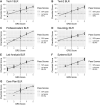Measuring the Quality of the OSCE in a Chiropractic Programme: A Review of Metrics and Recommendations
- PMID: 37773771
- PMCID: PMC11097219
- DOI: 10.7899/JCE-22-29
Measuring the Quality of the OSCE in a Chiropractic Programme: A Review of Metrics and Recommendations
Abstract
Objectives: The Objective Structured Clinical Examination (OSCE) is a commonly used assessment of clinical skill, and ensuring the quality and reliability in OSCEs is a complex, and on-going process. This paper discusses scoring schemas and reviews checklists and global rating scales (GRS) for marking. Also detailed are post-examination quality assurance metrics tailored to smaller cohorts, with an illustrative dataset.
Methods: A deidentified OSCE dataset, from stations with both a checklist and GRS, of 24 examinees from a 2021 cohort was assessed using the following metrics: Cut-scores or pass-rates, number-of-failures, R2, inter-grade discrimination, and between-group-variation. The results were used to inform a set of implementable recommendations to improve future OSCEs.
Results: For most stations the calculated cut-score calculated was higher than the traditional pass of 50% (58.9.8-68.4%). Number-of-failures were low for traditional pass rates and cuts-scores (0.00-16.7%), excepting Lab Analysis where number-of-failures was 50.0%. R2 values ranged from 0.67-0.97, but proportion of total variance was high (67.3-95.9). These data suggest there were potential missed teaching concepts, that station marking was open to examiner interpretation, and there were inconsistencies in examiner marking.Recommendations included increasing checklist detail and using a weighted marking scale, separating some stations into dichotomous and key-feature checklists, using GRSs specific to each station, and reviewing all future OSCEs with the metrics described to guide refinements.
Conclusions: The analysis used revealed several potential issues with the OSCE assessment. These findings informed recommendations to improve the quality of future examinations.
Keywords: Benchmarking; Checklist; Clinical competence; Reproducibility of results.
© 2023 Association of Chiropractic Colleges.
Conflict of interest statement
Figures


Similar articles
-
Done or Almost Done? Improving OSCE Checklists to Better Capture Performance in Progress Tests.Teach Learn Med. 2016 Oct-Dec;28(4):406-414. doi: 10.1080/10401334.2016.1218337. Teach Learn Med. 2016. PMID: 27700252
-
Inter-observer variance of examiner scoring in urology Objective Structured Clinical Examinations.Can Urol Assoc J. 2024 Apr;18(4):116-119. doi: 10.5489/cuaj.8571. Can Urol Assoc J. 2024. PMID: 38381940 Free PMC article.
-
Assessment Scores of a Mock Objective Structured Clinical Examination Administered to 99 Anesthesiology Residents at 8 Institutions.Anesth Analg. 2020 Aug;131(2):613-621. doi: 10.1213/ANE.0000000000004705. Anesth Analg. 2020. PMID: 32149757
-
Standardized examinees: development of a new tool to evaluate factors influencing OSCE scores and to train examiners.GMS J Med Educ. 2020 Jun 15;37(4):Doc40. doi: 10.3205/zma001333. eCollection 2020. GMS J Med Educ. 2020. PMID: 32685668 Free PMC article.
-
A systematic review and meta-analysis of measurement properties of objective structured clinical examinations used in physical therapy licensure and a structured review of licensure practices in countries with well-developed regulation systems.PLoS One. 2021 Aug 3;16(8):e0255696. doi: 10.1371/journal.pone.0255696. eCollection 2021. PLoS One. 2021. PMID: 34343213 Free PMC article.
Cited by
-
A study on the impact of open source metaverse immersive teaching method on emergency skills training for medical undergraduate students.BMC Med Educ. 2024 Aug 9;24(1):859. doi: 10.1186/s12909-024-05862-9. BMC Med Educ. 2024. PMID: 39123134 Free PMC article.
References
-
- Kobrossi T, Schut B. The use of the objective structured clinic examination (O.S.C.E.) at the Canadian Memorial Chiropractic College outpatient Clinics. J Can Chiropr Assoc. 1987; 31 (1): 21.
LinkOut - more resources
Full Text Sources
Miscellaneous

